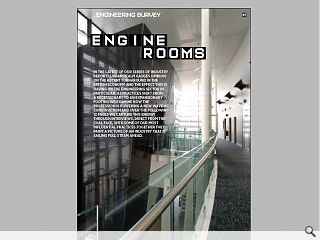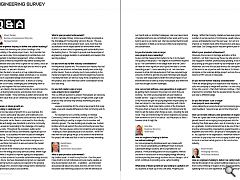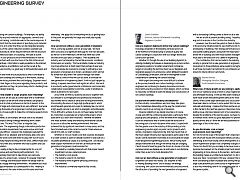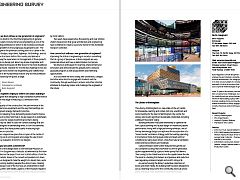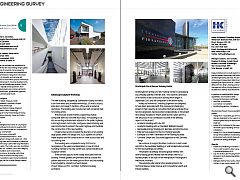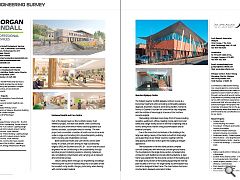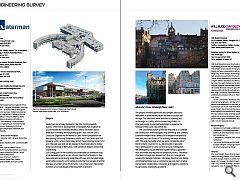Engineering Survey
22 Oct 2013
In the latest of our series of industry reports urban realm gauges opinion on the recent turnaround in the British economy and the effect this is having on the engineering sector in particular. As practices shift from a recessionary to an expansionary footing we examine how the profession is powering a new wave of construction and over the following 12 pages we capture this energy through interviews, direct from the coal face, with some of our most influential practices.Together they paint a picture of an industry that is sailing full steam ahead.
Q&A
Stuart Parker
Business Development Director,
Morgan Sindall
How are engineers helping to deliver low carbon buildings?
We believe that delivering low carbon buildings is the responsibility of the whole project team. Each member has a unique role to play; from engineering to architecture, cost management to facilities management. When combined, these areas of technical expertise help deliver building with low operation and costs which is great for our clients, and is an engaging space filled with natural light and air, which is great for end-users – a ‘win-win’ situation.
When the team can work in a truly collaborative way, whether it’s open meetings, design workshops or co-location, this kind of cooperative design environment is where engineers and designers work best. It allows us to bring together lots of ideas, challenging and developing them to identify and engineer the best overall solution.
As an industry, the real opportunities for us are to become better at sharing best practice and develop more robust investment models. These will help us better demonstrate the long-term value that can be created by investing in low carbon solutions.
What areas of future growth are you looking to capitalise on?
We see two real areas of growth for us as a business, the public sector; particularly education and healthcare; and infrastructure sectors; particularly utility services and nuclear.
In the public sector there is a real need for the industry to create and design new standards in practical community design as well as responding to the challenge of increasing energy costs. Throughout the recession, public sector investment was hard hit but still remains a significant part of the industry. As a business we have focused on intelligent engineering. This has helped us increase our turnover from the public sector throughout the recession and gives us a strong portfolio from which to win work when the market becomes more fluid.
The future of the infrastructure sector is really around growth in the energy and utility services arenas, where huge investment is required to improve ageing and dilapidated infrastructure as well as to provide sustainable energy sources for the future. We have developed and grown our specialist engineering teams to capture and respond to the growing high voltage (HV) and extra high voltage (EHV) distribution and transmission projects and schemes.
What is your proudest achievement?
In 2013, Carnegie Primary School was officially recognised as the first BREEAM ‘Outstanding’ school in the UK. This was a real credit to the whole project team. And, more than the accreditation we’ve helped deliver an environment where students can learn about engineering and sustainability from the building their in. This helps to provide real life examples of engineering, engage students in sustainability and support the learning syllabus.
Do you forsee any further industry consolidations?
Nothing would surprise me. The construction industry has had it tough as we all know and we have already seen some high profile failures. There is certainly much more positivity in the market and signs that an upward trend is beginning; however, I honestly feel there are still too many firms competing for too few projects and I don’t feel that further consolidation would be a bad thing.
Do you find smaller scale or larger scale projects more rewarding?
This is a difficult question to answer. Most people are obviously attracted by the glitz and glamour of high profile, large-scale projects; they certainly help develop marketing and press coverage.
However sometimes it’s the small scale projects that really make a real and valuable difference to their community and its users.
For example we are currently working on Hillhead Community Centre in Kirkintilloch, which is under £2m. The existing building is used by a range of local volunteer and statutory groups. The new building will provide new, modern facilities which will support the vital community services they provide. The new spaces will be more inspiring and engaging – making it a more pleasant place to be and work. When we met with the user group we got a real sense of the difference this project will make and that in itself is extremely rewarding.
David Narro
Director,
David Narro Associates
What is your proudest achievement?
My children aside – it must be my Practice. Over the years I have tried to recruit individuals who are clearly capable as structural engineers but who – in addition – are interested and passionate about structures and who are keen to find innovative and interesting solutions to fulfil the demands of our Clients and our Architect colleagues. We now have a team of talented staff who are committed to their work and try very hard to service our clients well. We have worked hard to build our reputation in fields as varied as architectural engineering and conservation.
Do you find smaller scale or larger scale projects more rewarding?
Scale is not the measure that matters to me or to my team. The quality of the project – the degree of involvement required by us – the commitment of the design team and the Client – all these are more significant and if good will lead to a more rewarding project – more rewarding for all. We have been involved in small intricate extensions that have required huge amounts of effort to get the structure minimised and elegant – but also with large projects where the overall impact of our involvement will be seen by many more people and where the scale has brought its own challenges.
How can we best enthuse a new generation of engineers?
By getting them involved in the project on which they are working. Too often young engineers are just treated as handle-turners – cogs in a machine – choose the metaphor. In my Practice we give the young engineers responsibility for their own projects – fee preparation, meetings with Clients and Architects. Most importantly control of the time spent. This gives them a chance to show their commitment and for them to get the kudos when things go well – including the end result. They are mentored by the senior engineers and always have someone to turn to for advice – but the project is theirs – however small it might be.
Alun Rae
Regional Director,
Waterman
How are engineers helping to deliver low carbon buildings?
Our core engineering disciplines work very closely with our in-house sustainability and BREEAM team to ensure sustainable design solutions are incorporated into our projects. From providing advice on local suppliers, method and form of construction to encouraging energy efficiency and incorporating low energy solutions into our designs - all of which contribute to providing a low carbon building.
What areas of future growth are you looking to capitalise on?
Our business is made up of two core areas, Property and Energy. Within the Property market we have seen growth in a number of our key sectors of Commercial, Health, Education, Leisure and Residential over the past year. Our aim is to improve our market share within these sectors and expand our client base. Our Energy section has seen growth year on year.
What is your proudest achievement?
Obviously the success of marriage and kids is at the forefront – not that I have to say this as my wife will not read this magazine. However, professionally speaking, it has to be plucking up the guts to leave my last employer to join Waterman, and over the last year witness the strengthening of the team to see us partner with the likes of Sir Robert McAlpine on the Seabraes Bridge project and also the second tranche of PFI Schools in Newcastle.
Do you foresee further industry consolidations?
There are always going to be surprises in this industry. If it suits one company to merge with another – or one company to buy into a sector – then that trend will continue. I think it’s important to remember that the people remain the same, they just wear a different badge.
Do you find smaller scale or larger scale projects more rewarding?
I enjoy delivering a successful project and receiving good client feedback. Size and scale are not that important.
How can we best enthuse a new generation of engineers?
There are a great deal more activities and organisations geared towards encouraging young engineers into the industry than there were when I was at University or working as a graduate. Constructionarium has to be one of the most practical and rewarding organisations geared towards young engineers and one which I am proud to have played a part in. As a sponsor of the organisation, Waterman have and continues to play a key role in encouraging student engineers to muck in and learn what goes on in the construction industry.
Brian Walker
Managing Director,
Will Rudd Davidson
How are engineers helping to deliver low carbon buildings?
We feel the design of low carbon buildings requires a change from normal thinking in respect of structural engineering. Speaking from our own experience, we have a significant role in delivering low carbon buildings. For example, our ability to specify recycled materials for aggregates, cements and structural framing, contributes well to the overall response. It is important that the implications of specifying such materials are clear to all in order that they can be integrated properly.
Many of the carbon reduction solutions available use bespoke products, which require interface with the structure and architectural fabric of a building. We take an active interest in such products and are well rehearsed on how to integrate them with our structures in the first instance and retrospectively. Information is easily available on the internet, and attendance at exhibitions such as the Ice lab at the Lighthouse recently, is a great way to stimulate discussion and interest.
More and more structural products which contribute to low carbon buildings are coming on to the market, dealing with some tricky problems like cold bridging. Engineers need to have their finger on the pulse regarding these products and their application so they can proactively inform a building’s low carbon design response.
Do you find smaller or larger projects more rewarding?
As a practice, we are just as comfortable with a multimillion pound project as we are with small domestic size projects. It is difficult to state a preference in terms of reward, as the nature of large and small projects are very different. Everyone will enjoy the kudos of a large project, and all going well the economy of scale ought to make the commercial aspects more rewarding.
However, as an example, we recall one of our smallest recent projects being strikingly rewarding from a team perspective. This was ‘The Chain’ at Hospital Gate, Clydebank. The engineering design, information production and articulation requirements here were unique and mind bogglingly difficult. However the challenges captured the imagination of our designer and technicians alike, who were taking the work home with them to play with ‘out of hours’. We all really enjoyed working with the artist, Jeffson Robb and the foundry men and craftsmen who had to patent and cast the installation.
The reality of day to day commercial life for us is not all glamorous and overflowing with excitement. It is fundamentally important to take things very seriously regardless of a projects size. However it is equally important to foster energy and enthusiasm within the design team to promote a happy working environment. We believe you must have happy employees as a prerequisite to this. Helping to make everyone’s life easier makes our life easier and more rewarding. We apply this to everything we do, so getting back to the point, we generally find large and small jobs equally rewarding.
How can we best enthuse a new generation of engineers?
This is a very big question and not an easy task. We have been conscious of a significant skills gap for over two decades. At the turn of the Millennium, we felt that there was some recovery from past years of neglect. Then suddenly the industry was hammered by the terrible economic conditions forced upon us recently. This has probably made our industry much less attractive to fresh talent than perhaps it ever was. There will always be recessions; one key to enthusing a new generation of engineers is to foster a profession which will fair no worse than any other if we cannot manage ‘fair better’.
There is a limit of what we can do alone, to enthuse the new generation of engineering talent. It will not just happen by talking; it requires investment and significant effort. We feel it is an industry wide (governmental, institutional, and corporate) collaborative responsibility to promote a suite of professions which is attractive to new talent.
At our level, we feel our business structure, together with our attitude to our employees and professional institutions has worked well to create an attractive working environment, transcending the allure of mega high profile projects, which are infrequent generally only open to relatively few. Our aim is a high quality service to all, which is energetic and enthusiastic. This is difficult to achieve if you do not have happy staff. We do, more than occasionally win a high profile project, which does serve as a short term motivator. However we believe one must achieve a deep and enduring motivational culture to secure an attractive working environment. We have achieved this by significant investment in many areas, and has benchmarked well in the current economic times where we stood firm with our staff numbers.
Whether or not our model is one that could be developed in a wider context is open for debate; however it was built on a visualised professional utopia as a starting point. An industry wide utopian framework for how we can enthuse the new generation of engineers could look like this:
The industry is suitably financed such that proper inward investment can be a natural process.
The industry is not greedy
The industry cares for its members
The industry works together perusing continuous improvement
The industry is universally respected by society
James Costello
Director, Hulley & Kirkwood Consulting Engineers Limited
How are engineers helping to deliver low carbon buildings?
Nowadays engineers in the Building Services sector are at the forefront of endeavouring to produce quality low carbon buildings in conjunction with our design teams and construction partners.
Whether it’s through the use of our Building physicists in utililsing modelling techniques or developing low to zero carbon engineering solutions, to better Government compliance targets or providing the technical input via our designers and registered assessors to achieve low carbon BREEAM Excellent or Outstanding Certification, the role of the engineer is now fundamental in delivering low carbon buildings.
With targets becoming ever more difficult to achieve as the journey towards zero carbon buildings continues, engineers are continuing to develop innovative and more importantly practical solutions in their designs, which continue to massively contribute to both the design and construction of low carbon buildings.
Do you foresee further industry consolidations?
Further industry consolidations will most likely take place in the marketplace depending on the way the construction industry reacts to us coming out of recession.
Financial stability of any design practice is of course crucial and with the continuing expectation, particularly from publicly procured projects, of low fee levels from designers, it can be understood why in some cases the attraction of becoming part of a multi-discipline offer exists. Coupled with this the greater use in the industry of BIM providing a total engineering solution again on public sector projects which will be a mandatory requirement by 2016 has meant that on the much larger infrastructure type projects particularly in the South, Clients have been more likely to look towards the larger multi-disciplined engineering practices. We at Hulleys have always maintained that though the trends may be changing, Clients should at least be given the choice to choose a firm like ourselves where we believe we can add value in our discipline rather than as part of a multi-discipline firm.
How can we best enthuse a new generation of engineers?
Engineers turn ideas into reality! Our strapline at H&K is “Making Buildings Work” and in today’s low energy consuming, low carbon and environmentally conscious world, the attraction of providing the next generation of engineers with a stimulating fulfilling career is there for all to see.
We are all still at present plodding along… hopefully on the way out of recession in the Construction industry.
However, over the next few years as there is improvement in the economy initiatives like the use of BIM and 3D modelling, prototyping of buildings, their energy performance and associated building physics along with the importance of the whole life of buildings and their total facilities management must add to the attraction of a career in engineering.
The contribution that can be made to the industry and society in general from a new generation of engineers from involvement in these initiatives alone needs to be highlighted to all those involved in recruitment to our profession and ensure its future will be in safe hands.
Robert Storey
Managing Director, Glasgow,
Scott Bennett Associates
What areas of future growth are you looking to capitalise on?
One of our traditional areas of work is urban regeneration and affordable housing . In the last few years funding limits have made brown field development difficult for most of our clients. Whilst some larger developers and local authorities have been able to continue to some extent this has inevitably reduced substantially . I believe that there will be an upturn in this market in the next few years as it becomes more of a political issue. We have retained a lot of our experienced staff despite the problems of the last few years , we have managed to maintain what I think is a good reputation for providing a quality service and so I think we are well positioned to take advantage of this in the future.
Do you find smaller scale or larger scale projects more rewarding?
For me it’s not the scale of the project that’s important. The one off private house with its bespoke details can be just as interesting as the multi-storey office development or large urban regeneration project that completely changes an area. There is no doubt that you are likely to be have more of a personal involvement on the smaller project and possibly the engineering is more obvious to the laymen , particularly when the building makes an architectural statement. So its nice to have your input recognised in this way. However the rewards from coordinating a team of people and solving the type of large scale problems you come across in regeneration work is also very rewarding, even if it is under the radar for most of the general public.
How can we best enthuse a new generation of engineers?
There is no doubt in my mind that engineering in general but particularly Civil and Structural engineering is one of the most exiting professions in which to be involved and should have no problem in encouraging young people to join . The basic degree is the potential starting point for a career in the design of bridges, large dams, highways, tall buildings, arena’s , off shore structures both in this country and abroad or alternatively the supervision or management of these projects. Today we can design just about any shape imaginable and I believe these techniques will filter down to the more traditional jobs in the future. However for me the real challenge is how we encourage more women into engineering and I believe that this is one of the fundamental reasons why the the profession is under valued by the public at large.
Stuart Munro
Principal for Scotland,
Buro Happold
How are engineers helping to deliver low carbon buildings?
We recognise that designing to high standards of performance is only the first stage in reducing CO2 emissions from buildings.
The quality of the construction, the performance of the building services equipment and the way that buildings are used all govern energy demand in practice.
Before requiring more demanding levels of performance, we believe it is important that in-house research is undertaken. This captures the range of performance that is being achieved by our ‘best in class’ low carbon buildings that are already designed to demanding levels, in turn this identifies any measures that have proved useful in ensuring high performance in practice.
At Buro Happold we place the occupier at the centre of everything we do and regularly encourage the use of post occupancy evaluation to inform our designs.
What is your proudest achievement?
To be part of the design team on the Riverside Museum of Transport in Glasgow was a fantastic achievement by the team who worked on the project from our Scottish offices. From the smooth metallic sheen of the curved and pleated roof, down to the floor designed to take the weight of a steam train, work on this stunning building required the utmost care. Creating the spectacular look of the roof was an achievement in itself but many other, well hidden, aspects of the museum required exceptional engineering, even though they may go unnoticed by most visitors.
Two years have passed since the opening and over 2million visitors have proven that great architecture and engineering have combined to create a successful home for this incredible transport collection.
How can we best enthuse a new generation of engineers?
Improving the status of engineering in society is something that as a group of people we, at Buro Happold are very passionate about and have a determination to improve.
We share an enthusiasm for learning, improvement and innovation and demonstrate this globally with a fantastic graduate program as well as placement and internship opportunities.
At a local level we work closely with universities, colleges and other educators to engage with students and the community through workshops, lectures and other informal initiatives to hopefully inspire and challenge the engineers of the future.
|
|
Read next: Sighthill
Read previous: Mareel
Back to October 2013
Browse Features Archive
Search
News
For more news from the industry visit our News section.
Features & Reports
For more information from the industry visit our Features & Reports section.


